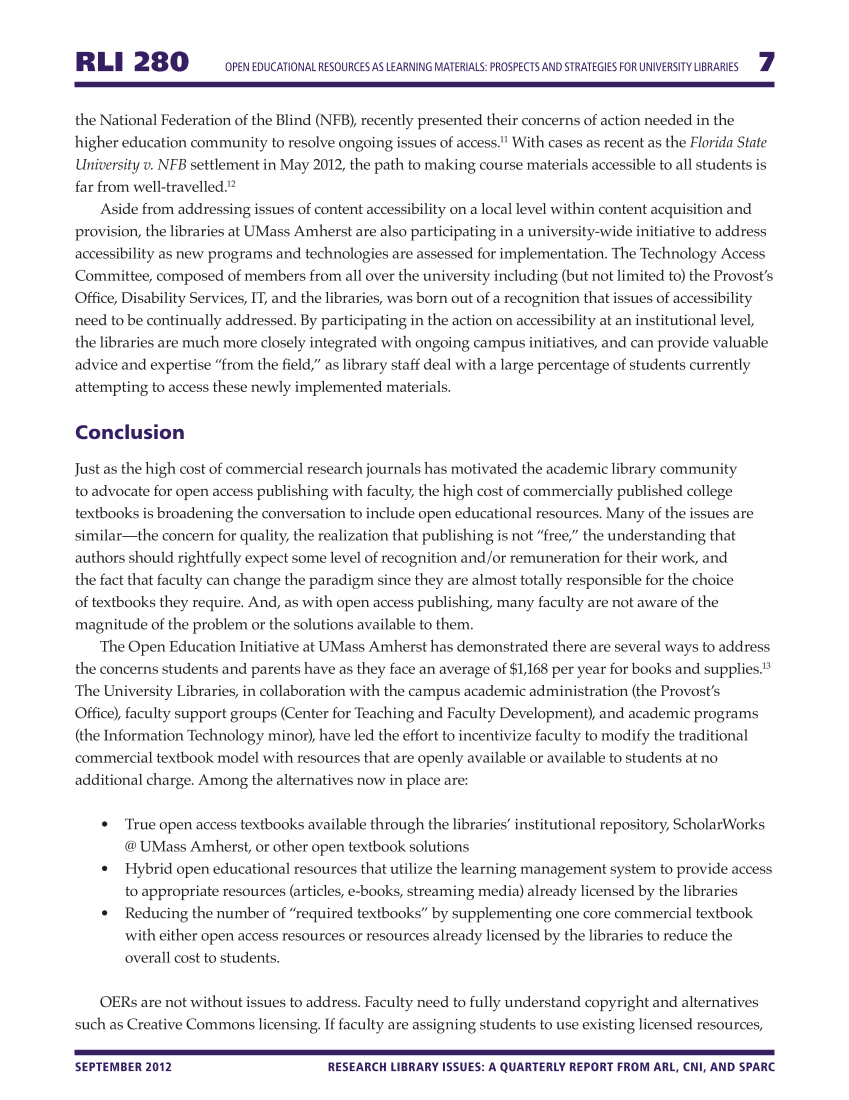RLI 280 Open Educational Resources as Learning Materials: ProOspects and Strategies for University Libraries 7 SEPTEMBER 2012 RESEARCH LIBRARY ISSUES: A QUARTERLY REPORT FROM ARL, CNI, AND SPARC the National Federation of the Blind (NFB), recently presented their concerns of action needed in the higher education community to resolve ongoing issues of access.11 With cases as recent as the Florida State University v. NFB settlement in May 2012, the path to making course materials accessible to all students is far from well-travelled.12 Aside from addressing issues of content accessibility on a local level within content acquisition and provision, the libraries at UMass Amherst are also participating in a university-wide initiative to address accessibility as new programs and technologies are assessed for implementation. The Technology Access Committee, composed of members from all over the university including (but not limited to) the Provost’s Office, Disability Services, IT, and the libraries, was born out of a recognition that issues of accessibility need to be continually addressed. By participating in the action on accessibility at an institutional level, the libraries are much more closely integrated with ongoing campus initiatives, and can provide valuable advice and expertise “from the field,” as library staff deal with a large percentage of students currently attempting to access these newly implemented materials. Conclusion Just as the high cost of commercial research journals has motivated the academic library community to advocate for open access publishing with faculty, the high cost of commercially published college textbooks is broadening the conversation to include open educational resources. Many of the issues are similar—the concern for quality, the realization that publishing is not “free,” the understanding that authors should rightfully expect some level of recognition and/or remuneration for their work, and the fact that faculty can change the paradigm since they are almost totally responsible for the choice of textbooks they require. And, as with open access publishing, many faculty are not aware of the magnitude of the problem or the solutions available to them. The Open Education Initiative at UMass Amherst has demonstrated there are several ways to address the concerns students and parents have as they face an average of $1,168 per year for books and supplies.13 The University Libraries, in collaboration with the campus academic administration (the Provost’s Office), faculty support groups (Center for Teaching and Faculty Development), and academic programs (the Information Technology minor), have led the effort to incentivize faculty to modify the traditional commercial textbook model with resources that are openly available or available to students at no additional charge. Among the alternatives now in place are: • True open access textbooks available through the libraries’ institutional repository, ScholarWorks @ UMass Amherst, or other open textbook solutions • Hybrid open educational resources that utilize the learning management system to provide access to appropriate resources (articles, e-books, streaming media) already licensed by the libraries • Reducing the number of “required textbooks” by supplementing one core commercial textbook with either open access resources or resources already licensed by the libraries to reduce the overall cost to students. OERs are not without issues to address. Faculty need to fully understand copyright and alternatives such as Creative Commons licensing. If faculty are assigning students to use existing licensed resources,




























